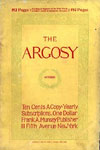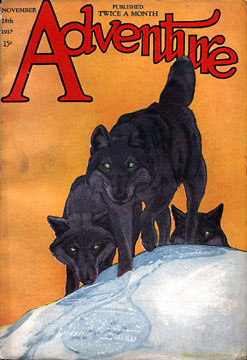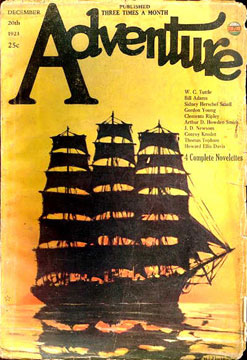Adventure Magazine: America's No. 1 Pulp
Adventure magazine first appeared on newsstands in October 1910. In its first decade of publication, it carried fiction by such notable authors as Rider Haggard, William Le Queux, John Buchan, Rafael Sabatini, Baroness Orczy, and H. Bedford-Jones. By the 1920s, Adventure had become one of the most profitable and critically acclaimed magazines of its kind, and in 1935, it would be hailed as "The No. 1 Pulp" by the editors of Time.
Adventure was first published by the Ridgway Co., which Erman Ridgway had sold to the Butterick Publishing Co. in 1909. Though no records exist today to explain why a publisher specializing in dress-patterns-who also published the family-oriented Everybody's Magazine-would decide to enter the pulp magazine market in 1910, Richard Bleiler surmises that market research probably showed that readers existed for yet another adult fiction/fact magazine along the lines of already successful titles like Argosy, All-Story, Red Book, and Street & Smith's The Popular Magazine.
Noted explorer and journalist Trumbull White became the magazine's first editor, and though he remained in the position barely over a year, White would establish two precedents guiding Adventure's editorial policies for years to come: 1) an "adventure" story did not have to be set in an exotic location; and 2) the story should be as "correct" as possible: historically, geographically, and socially accurate to the detail.
Adventure's reputation as "The No. 1 Pulp", however, stems from the editorship of Arthur Hoffman, who succeeded White in February 1912. Hoffman introduced several key features establishing Adventure as more than just a magazine; the editorial pages column known as "The Camp-Fire;" "Lost Trails," which helped re-unite readers with lost family and friends; "Wanted-Men and Adventurers," a "Help Wanted" section for those interested in excitement and adventure; and "Ask Adventure," wherein readers submitted questions to the magazine's international panel of experts.
Hoffman remained editor for fifteen years, during which time the magazine reached its peak circulation of over 300,000; published three times monthly; developed an international audience of devoted readers; and became one of Theodore Roosevelt's favorite magazines. Hoffman was succeeded by Joseph Cox in 1927, who was himself replaced less than a year later by Anthony Rud (1927-30), and a string of similarly unremarkable editors followed for many years thereafter.
Although Adventure magazine would continue to be published up until 1971-undergoing a number of new format changes and outlasting all its major rivals-the period of Hoffman's editorship (1912-1927) represents a high-water mark in the magazine's history-in terms of both its quality and popularity. In April 1953, the magazine changed its format a final time to that of a men's adventure magazine; and by 1960, according to Bleiler, it had become "...a dying embarassment, printing grainy black and white photos of semi-nude women".
Patrick Scott Belk, The University of Tulsa
Works Cited and Consulted
Bleiler, Richard, "A History of Adventure Magazine." The Index to Adventure Magazine. Bibliographies on CD-ROM. Oakland, CA: Locus Press, 2009.
"The No. 1 Pulp," Time Magazine, 21 October 1935, p. 40.
Peterson, Theodore. Magazines in the Twentieth Century. Urbana, IL: University of Illinois Press, 1964: p. 165.





